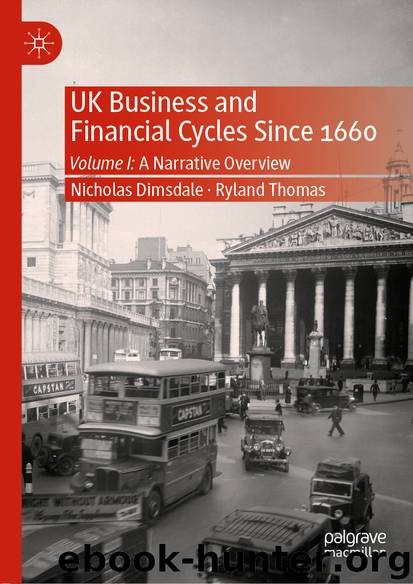UK Business and Financial Cycles Since 1660 by Nicholas Dimsdale & Ryland Thomas

Author:Nicholas Dimsdale & Ryland Thomas
Language: eng
Format: epub
ISBN: 9783030263461
Publisher: Springer International Publishing
Chart 6.32Balance of trade in goods
(Notes Imports of goods are on a balance of payments “free on board” basis in this calculation. Source Thomas and Dimsdale 2017)
The Bank has been criticised for its expansionary policy stance during the early 1820s. There was a tightening in the form of a major sale of Exchequer bills early in 1825, but no rise in interest rates until December. At this time Bank rate went up from 4% to the maximum of 5% allowed by the usury laws, when the financial crisis was at its height (Chart 6.33). The Bank’s reserves fell steeply from £14 million at the start of 1824 to only around £2 million in December 1825. The reserves benefited from a timely loan from France at a critical juncture. The Bank restricted its discounts as pressures in the money market mounted during 1825, but it did discount freely in the later stages of the crisis. At this late stage, it lent generously on a wide range of assets in order to check the panic in the money market. The Bank was starting to learn about its responsibility towards the money market in a time of crisis. But it had much further to go before it accepted its duties as lender of last resort. This function was not fully recognised until the financial crisis of 1866 (Bagehot 1873; King 1936; Anson et al., 2017).
Chart 6.33Interest rates
(Source Thomas and Dimsdale 2017)
Download
This site does not store any files on its server. We only index and link to content provided by other sites. Please contact the content providers to delete copyright contents if any and email us, we'll remove relevant links or contents immediately.
Pale Blue Dot by Carl Sagan(4886)
The Rules Do Not Apply by Ariel Levy(4822)
Goodbye Paradise(3710)
Ogilvy on Advertising by David Ogilvy(3482)
Liar's Poker by Michael Lewis(3353)
Delivering Happiness by Tony Hsieh(3353)
Into Thin Air by Jon Krakauer(3289)
Purple Cow by Seth Godin(3127)
Rogue Trader by Leeson Nick(2960)
The Social Psychology of Inequality by Unknown(2922)
The Airbnb Story by Leigh Gallagher(2784)
4 - Harry Potter and the Goblet of Fire by J.K. Rowling(2639)
The Mind Map Book by Tony Buzan(2498)
Bossypants by Tina Fey(2449)
Claridge's: The Cookbook by Nail Martyn & Erickson Meredith(2345)
All the President's Men by Carl Bernstein & Bob Woodward(2315)
Six Billion Shoppers by Porter Erisman(2254)
Master of the Game by Sidney Sheldon(2225)
Alibaba by Duncan Clark(2027)
